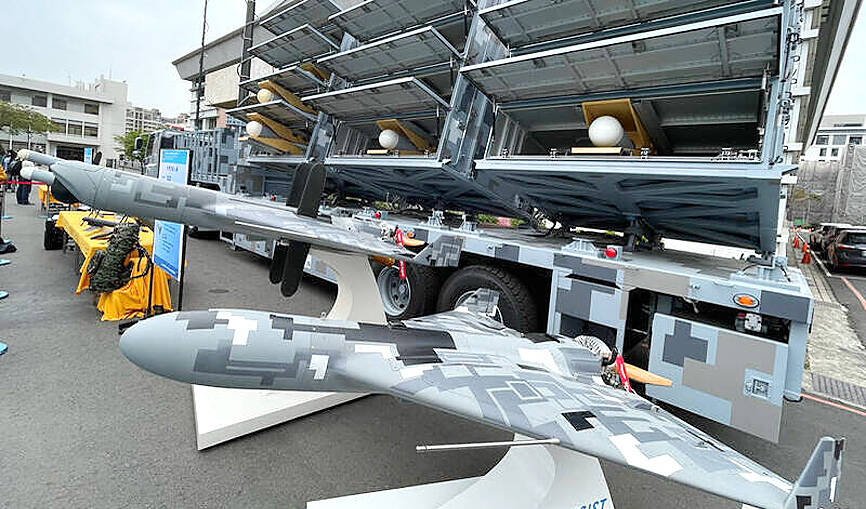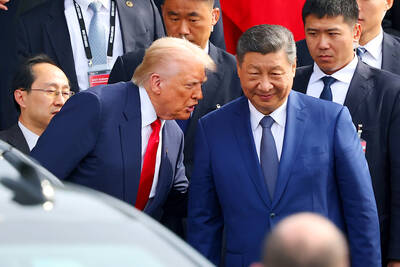The Ministry of National Defense (MND) has included the funding needed to mass-produce Type-1 and Type-2 suicide drones in next year’s budget plan, a military source said yesterday.
Although the US government last month approved sales of Switchblade 300 loitering munitions and Altius 600M-V uncrewed aerial vehicles to Taiwan, which are scheduled for delivery between this year and the next, military leaders assessed that Taiwan would still have an inadequate number of attack drones to bolster national defense, the source said, asking to remain anonymous.
Taiwan needs to mass produce locally made attack drones, including Type-1 and Type-2 suicide drones, they said.

Photo: Taipei Times file
Meanwhile, mass production of Chien Hsiang anti-radiation drones, developed by the Chungshan Institute of Science and Technology, would be completed next year, they said.
The anti-radiation drone’s functions would be improved, while the ministry would continue to produce drones with enhanced functions at a smaller scale using the annual defense budget, the source said.
Chien Hsiang drones are designed to lock in on and attack radar stations, including those on ships, while Type-1 and Type-2 suicide drones are mainly used by ground troops on anti-armor missions, they said.
Similar to the Switchblade 300, Type-1 suicide drones are designed as easy-to-use equipment for soldiers and can be deployed quickly, the source said.
The flight time of a Type-1 suicide drone is about 15 minutes, with a guided control range exceeding 10km, institute data showed.
Type-2 suicide drones have a longer flight time, and can carry out reconnaissance and attack missions beyond visual range using imagery, infrared and microwave systems to trace targets. They can also be used for swarm attacks and can be installed on ships and vehicles.
In other news, the navy might conduct a sinking exercise during the one-month live-fire drills after the Han Kuang exercises.
The Sink Exercise (SINKEX) program is one of the highlights of the second phase of the Rim of the Pacific exercises, which are to begin today. Military units participating in the SINKEX exercise are to use a range of anti-ship weapons to sink the retired 40,000-tonne USS Tarawa, an amphibious assault ship.
The Maritime and Port Bureau on Friday announced that the navy is to conduct live-fire training from July 30 to Aug. 30.
The drills would be conducted in three main areas.
The first area would be in the waters and airspace east of Taitung and Pingtung counties, and west of Green Island (綠島) and Orchid Island (Lanyu, 蘭嶼), the bureau said.
The second area covers the sea and airspace extending from the east coast of Taiwan more than 140km from the east coasts of Green and Orchid islands.
The third area covers sea and airspace south of Hengchun Peninsula (恆春半島) and Orchid island.
The live-fire training would be conducted by the Navy Command Headquarters, rather than by the Chungshan Institute as in the past, the bulletin said.
Based on what the navy is currently using, the live-fire training could include anti-ship and anti-aircraft missiles, such as Hsiung Feng III missiles, which are capable of destroying land-based and naval targets.

UKRAINE, NVIDIA: The US leader said the subject of Russia’s war had come up ‘very strongly,’ while Jenson Huang was hoping that the conversation was good Chinese President Xi Jinping (習近平) and US President Donald Trump had differing takes following their meeting in Busan, South Korea, yesterday. Xi said that the two sides should complete follow-up work as soon as possible to deliver tangible results that would provide “peace of mind” to China, the US and the rest of the world, while Trump hailed the “great success” of the talks. The two discussed trade, including a deal to reduce tariffs slapped on China for its role in the fentanyl trade, as well as cooperation in ending the war in Ukraine, among other issues, but they did not mention

Japanese Prime Minister Sanae Takaichi yesterday lavished US President Donald Trump with praise and vows of a “golden age” of ties on his visit to Tokyo, before inking a deal with Washington aimed at securing critical minerals. Takaichi — Japan’s first female prime minister — pulled out all the stops for Trump in her opening test on the international stage and even announced that she would nominate him for a Nobel Peace Prize, the White House said. Trump has become increasingly focused on the Nobel since his return to power in January and claims to have ended several conflicts around the world,

CALL FOR SUPPORT: President William Lai called on lawmakers across party lines to ensure the livelihood of Taiwanese and that national security is protected President William Lai (賴清德) yesterday called for bipartisan support for Taiwan’s investment in self-defense capabilities at the christening and launch of two coast guard vessels at CSBC Corp, Taiwan’s (台灣國際造船) shipyard in Kaohsiung. The Taipei (台北) is the fourth and final ship of the Chiayi-class offshore patrol vessels, and the Siraya (西拉雅) is the Coast Guard Administration’s (CGA) first-ever ocean patrol vessel, the government said. The Taipei is the fourth and final ship of the Chiayi-class offshore patrol vessels with a displacement of about 4,000 tonnes, Lai said. This ship class was ordered as a result of former president Tsai Ing-wen’s (蔡英文) 2018

GLOBAL PROJECT: Underseas cables ‘are the nervous system of democratic connectivity,’ which is under stress, Member of the European Parliament Rihards Kols said The government yesterday launched an initiative to promote global cooperation on improved security of undersea cables, following reported disruptions of such cables near Taiwan and around the world. The Management Initiative on International Undersea Cables aims to “bring together stakeholders, align standards, promote best practices and turn shared concerns into beneficial cooperation,” Minister of Foreign Affairs Lin Chia-lung (林佳龍) said at a seminar in Taipei. The project would be known as “RISK,” an acronym for risk mitigation, information sharing, systemic reform and knowledge building, he said at the seminar, titled “Taiwan-Europe Subsea Cable Security Cooperation Forum.” Taiwan sits at a vital junction on